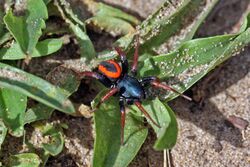Biology:Psammorygma
| Psammorygma | |
|---|---|

| |
| P. aculeatum | |
| Scientific classification | |
| Domain: | Eukaryota |
| Kingdom: | Animalia |
| Phylum: | Arthropoda |
| Subphylum: | Chelicerata |
| Class: | Arachnida |
| Order: | Araneae |
| Infraorder: | Araneomorphae |
| Family: | Zodariidae |
| Genus: | Psammorygma Jocqué[1] |
| Type species | |
| Psammorygma caligatum | |
| Species | |
| |
Psammorygma is a genus of African ant spiders found in the deserts of southern Africa, namely the Kalahari desert and the Namib desert.[2] They are somewhat larger spiders, growing up to twenty millimeters in length. The carapace and chelicerae are brightly colored, while the legs and abdomen are generally a darker black or gray. They can be distinguished from other genera by a knob-like proximal extension found on the cheliceral fang and a double row of dorsal spines in a specific location.[2] First described in 1991 by Jocqué, the name is from the Greek psammon, meaning "sand", and orugma, meaning "mine", in reference to the sandy tunnels these spiders live in.[2] (As of February 2019), it contains only three species: P. aculeatum, P. caligatum, and P. rutilans.[1]
References
- ↑ 1.0 1.1 "Zodariidae". Natural History Museum Bern. http://www.wsc.nmbe.ch/genus/3870.
- ↑ 2.0 2.1 2.2 Jocqué, R. (1991). "A generic revision of the spider family Zodariidae (Araneae)". Bulletin of the American Museum of Natural History 201: 125–128.
Wikidata ☰ Q2522839 entry
 |

